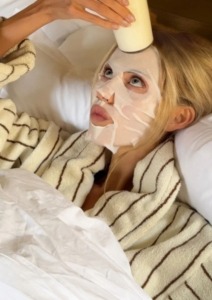Does a facial oil serum always have to be the final step in your skincare routine?
Skin School Series
by Kristina Mikulić GazdovićNovember 13, 2025
Skin School Series
by Kristina Mikulić GazdovićNovember 13, 2025


While studying skincare rules and advice, I often find myself thinking, it’s not that serious. I’ll be the first to admit that many of the so-called strict skincare rules are overblown, unnecessarily complicated, or simply untrue. This becomes especially clear when it comes to the order of steps in a routine.
Which order is actually correct? Does it even matter? Will applying products in the wrong sequence make them less effective? In today’s article, part of the Skin School series, we’re answering these questions—and explaining how to get the most out of your products by applying them in the ideal order.
From the lightest to the thickest—that’s the general rule when it comes to textures. Excluding cleansing and makeup removal, the correct order for applying serums, toners, essences, and creams can be confusing for many.
Most people would assume that serum comes before moisturizer. But what if your face cream is actually a lightweight gel-cream, while your powerful anti-aging serum has an oil base and a thicker texture? Should you then switch the order? And if you introduce milky mists or serums that are technically emulsions (a blend of water and oil), how can you be sure you’re applying them the right way?

Courtesy of Gisou
Following the texture rule, starting with lighter products, then thicker ones, and finishing with oil-based textures, is generally a good guideline. In most cases, that order works well. Confusion often arises, however, when using a lightweight cream and an oil-based serum. Technically, serums should be applied before creams, but based on texture, in this case, the cream should go on first. No wonder that paradox leaves many people puzzled.
In general, oil-based serums work best when applied at the end of your skincare routine. Oil acts as an occlusive layer, creating a barrier that prevents water from evaporating from the skin (known as TEWL – transepidermal water loss). If all the previous steps in your routine involve watery, gel-like, or milky textures, it’s best to apply the oil-based serum last, even after a gel-cream, regardless of the fact that it’s labeled as a serum.
Products with watery or gel textures don’t contain oils or enough occlusives to effectively “seal in” moisture. That’s why, in this case, an oil-based serum should be the final step in your routine.
If your routine includes classic nourishing, rich, and thick creams, it’s not necessary for the oil-based serum to come at the end. You can freely massage the serum into the skin first and then apply your rich cream afterward. In this case, the order is up to you. It’s also common, especially if you have dry skin, to mix both products in your palm and create your own customized serum-cream with a highly occlusive texture.

Courtesy of Onitsuka Tiger
As with most things in skincare, there isn’t one rule that works for everyone. While the order in which you apply your products matters for getting the best results, it doesn’t always have to be strictly defined. The key is to understand the textures and functions of each product. Lightweight formulas go underneath heavier ones, and oils usually come last—unless your routine or skin type calls for a different approach.
Instead of blindly following rules, pay attention to how your skin responds. The best routine is the one that works for you and that you actually enjoy using, not the one most often repeated on social media.